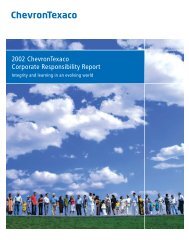Chevron Corporate Responsibility Report 2009
Chevron Corporate Responsibility Report 2009
Chevron Corporate Responsibility Report 2009
Create successful ePaper yourself
Turn your PDF publications into a flip-book with our unique Google optimized e-Paper software.
Renewable Energy<br />
Emerging Energy<br />
<strong>Chevron</strong> is a world leader in developing and delivering energy from oil and<br />
natural gas, which will remain the world’s predominant sources of energy for<br />
decades to come. To meet the growing demand of developing economies, we<br />
will need every energy source available, including efficiency and renewables.<br />
We believe that the skills honed over our<br />
130 years of experience to find, produce<br />
and deliver energy will one day lead to<br />
commercial-scale development of renewable<br />
resources. To reach this point, we are<br />
focusing on research and development of<br />
renewable energy technologies that are<br />
scalable, sustainable and profitable.<br />
<strong>Chevron</strong> is taking a pragmatic approach to<br />
renewable energy — pursuing and focusing<br />
on those technologies that leverage our<br />
core competencies, assets or competitive<br />
advantage. These include geothermal,<br />
advanced biofuels, solar, and energy efficiency<br />
technologies. We conduct internal<br />
research and collaborate with governments,<br />
businesses and academia in researching<br />
and developing alternative and renewable<br />
energy sources. Through these partnerships,<br />
we share information and are helping<br />
advance technology as we look at providing<br />
renewable energy for future generations.<br />
Geothermal Energy<br />
<strong>Chevron</strong> is the largest producer of geothermal<br />
energy in the world, supplying<br />
1,273 megawatts of installed electricitygenerating<br />
capacity in Indonesia and the<br />
Philippines. Our facilities provide enough<br />
energy to meet the needs of 16 million<br />
people in these countries. Technologies<br />
and processes used in geothermal production<br />
have much in common with those for<br />
oil and gas. <strong>Chevron</strong> leverages its experience<br />
in reservoir characterization and<br />
drilling safely and efficiently to produce<br />
this renewable resource.<br />
Energy Efficiency Business<br />
We believe the most immediate and costeffective<br />
new sources of energy come from<br />
conservation and energy efficiency. Our<br />
subsidiary <strong>Chevron</strong> Energy Solutions Co.<br />
(CES) is dedicated to helping its clients and<br />
our own company become more energy<br />
efficient and reduce emissions through<br />
facility upgrades and the incorporation of<br />
renewable and alternative energy sources.<br />
<strong>Chevron</strong> is the only one of our peer group<br />
of companies that has made a viable business<br />
out of energy efficiency.<br />
In <strong>2009</strong>, we reinforced our commitment to<br />
efficiency by endowing the <strong>Chevron</strong> Chair<br />
in Energy Efficiency at the University of<br />
California at Davis. The person appointed<br />
will direct the world’s first university center<br />
of excellence in energy efficiency.<br />
In <strong>2009</strong>, <strong>Chevron</strong> Energy Solutions<br />
completed a 100-kilowatt solar photovoltaic<br />
system for the U.S. state of Colorado<br />
at its Department of Revenue building<br />
and a 10-kilowatt solar system at the<br />
State Capitol building. The installations<br />
were part of a CES-managed $20 million,<br />
six-year energy upgrade of more than 20<br />
buildings and included energy-efficient<br />
lighting, heating, ventilation and air conditioning;<br />
energy management systems;<br />
water conservation; and ground-source<br />
heating and cooling at the governor’s residence.<br />
The comprehensive project, which<br />
resulted in the U.S. Green Building Council’s<br />
LEED certification of five buildings, is<br />
expected to reduce energy costs by more<br />
than 25 percent and reduce CO 2 emissions<br />
by more than 7,600 metric tons per year,<br />
equivalent to removing nearly 1,500 cars<br />
from the road.<br />
CES also completed in <strong>2009</strong> the nation’s<br />
largest energy efficiency and solar<br />
Stakeholder<br />
Engagement<br />
Research Partnership<br />
Exploring the potential benefits associated<br />
with any emerging energy source can be<br />
encouraging. But the path to commercializing<br />
new energy sources presents many challenges.<br />
The best way to solve these challenges<br />
is through collaboration. <strong>Chevron</strong>’s strategy<br />
for biofuels development is to collaborate<br />
with the best talent at other companies,<br />
universities and government laboratories —<br />
to combine their knowledge of biomass with<br />
<strong>Chevron</strong>’s expertise in making high-quality<br />
transportation fuels. Partnerships include<br />
Catchlight Energy LLC, our joint venture with<br />
Weyerhaeuser Co., and collaborations with the<br />
U.S. National Renewable Energy Laboratory,<br />
Georgia Institute of Technology, University<br />
of California at Davis, Texas A&M University,<br />
and the Colorado Center for Biorefining<br />
and Biofuels.<br />
In developing advanced biofuels, successful<br />
feedstocks need to be scalable, sustainable<br />
and economically viable. They must have<br />
optimal physical and chemical properties<br />
and be able to thrive on marginal land that<br />
would not otherwise be used for food. Over<br />
the past few years, <strong>Chevron</strong> acquired a<br />
tremendous amount of knowledge about<br />
biomass and narrowed its list of potential<br />
biofuel feedstocks from more than 100 to<br />
fewer than 10.<br />
Left: Michelle Long, manager of feedstock<br />
supply for the Biofuels business unit of<br />
<strong>Chevron</strong> Technology Ventures, inspects a<br />
field of castor at College Station, Texas. Castor<br />
produces seeds that are not used for food.<br />
The seeds are crushed to release an oil that<br />
could be converted to transportation fuel.<br />
13

















